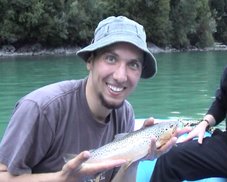1. Question: Why do they dry the logs before making the rafts?
The Kontiki raft I saw in the Norweigeian museum specifically
said that their first version sank because the logs were dry, so
on the second version they used fresh (i.e. still moist) logs,
and made sure they stayed moist while they made the raft.
2. Would it make sense to put like a "V" shape of logs up front
so that it cuts through the water and clears away any debris?
Haven't seen any Peru pictures like that, don't know if it's not
allowed.
3. The pictures on the blogs - wow, I didn't realize you would
be sitting more like IN the river if you don't have seats.
Dale's raft has nice wooden benches as seen in the picture of
Day two. I agree, let's each carry a roll of foam and pad our
seats, may make a world of difference.
-Lili
Wednesday, May 30, 2007
Raft Design Questions - Lili
Subscribe to:
Post Comments (Atom)




2 comments:
1. Maybe with the Contiki they knew that the logs would be in the water long enough to become completely saturated, so they had to know that the logs would still float when they were saturated?? Just a guess.
I'm pretty sure that the drier they are, the lighter and more maneuverable they will be and that it's just a matter of treating them to keep as much water out as possible. I'll ask Dale about their rafts, and we will definitely check with the locals for their advice and input in the building process. Maybe I'm wrong and they really do use wet logs.
2. Mike Collis mentioned that the standard rafts have their bows "carved out for streamlining". I'm not sure exactly what that means, but we could probably do it any way we like. I'm thinking that the more widely-spaced the logs are, the more cumbersome the raft will be because whenever you turn it, you have to push around all the water trapped between the logs. So maybe if we make it narrow with no gaps (or small gaps), then taper the front.
I'm not sure if it would be more efficient to leave the logs the same length at the bow but taper them individually so that each log is as streamlined as possible, or to try to shape them all together into one solid streamlined piece?? You're the rocket scientist, Lili - you tell me =P
-Robyn
Wow, you guys are really serious about this! I discovered your site because it showed up on my server stats as feeding hits onto my site. (No complaints there...)
Here is some general feedback on a couple of the questions.
I was under the DISTINCT IMPRESSION that the logs were dry. There are a couple of reasons for that. 1) A couple of the locals told me they were fire dried. 2) A lot of the logs had cracks running along them that I would not have expected on fresh logs. i.e. they LOOKED very dry. Having said that, I COULD BE WRONG. Unfortunately, I didn't even know about the race far enough ahead to think about building my own raft. I think it's incredibly cool that you guys are trying to do it.
I think what Mike Collis is referring to is that the logs are generally tapered at the ends with a machete. Just imagine an unsharpened pencil vs. a sharpened one. That's basically it.
I think I told this to Robyn in an email, but when it comes to number of logs... When we arrived all the "international teams" were given rafts with eight widely spaced logs. This made them float a bit better and gave them stability. As I remember, most of the local teams only had six logs, however. This made for lighter rafts. The spacing of the logs was also different. I remember two common designs. The first was to have six logs evenly spaced, but spaced much closer together than the rafts made for international teams. The second was to have two sets of three logs that were very close together with a wider gap in between. Kind of like two pontoons.
I think if you are really there early enough to build your own and you meet some local crews who are doing the same they will be more than happy to give you advice. They were really helpful to us last year whenever we needed it, though it definitely helps to speak some Spanish.
The most important thing is just to have a sense of adventure. No matter what you expect, things will be different. Even if I am able to return again this year I expect that things will be very different than last year. Just be open to the possibility that ANYTHING can (and will) happen.
Oh, and I hope that my blog had a little bit to do with inspiring you all to put yourselves through this :-)
Feel free to contact me at any time if you have questions. Robyn knows how to track me down!
Cheers,
Dale
Post a Comment